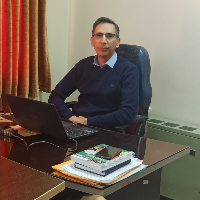Studying Speakers' Attitudes towards Kurdish, Kermanshahi Persian, and Standard Persian in Kermanshah Using Matched Guise Technique
Language plays a vital role in human personal and social lives, shaping beliefs, emotions, and attitudes towards mother tongue and other languages. Linguistic attitude, defined as emotional disposition towards languages (Crystal, 1997), can lead individuals to prefer one language over another due to various social, cultural, economic, historical, and identity factors. This preference can impact language survival or decline, with attitudes towards vernacular languages crucial for their preservation. Kermanshah, a city in western Iran with speakers of Kurdish, Kermanshahi Persian, and Standard Persian, exemplifies this dynamic, where assessing linguistic attitudes influences the preservation or marginalization of languages within the community.Generally, to assess speakers' attitudes towards different language varieties, direct or indirect methods are used. However, there is a limited number of studies conducted within Iran that employ direct or indirect methods to gauge speakers' linguistic attitudes. In most studies conducted in Iran, the focus has predominantly been on the status and use of language varieties within various linguistic communities. The only internal study that employed an indirect method and Matched Guise Test is the study by Pirouzfar and Eliasi (2014). In contrast to internal studies, foreign studies mostly rely on indirect methods and utilize Matched Guise Test. Lambert's Matched Guise Test, introduced in 1960, gauges attitudes toward language variations in bilingual groups. Participants hear recordings of the same speaker using different accents or styles and rate their personality, social status, and other traits, revealing how language impacts social perceptions.
The study utilized the Matched-Guise Test to investigate the status and dynamics of Kurdish, Kermanshahi Persian, and Standard Persian in Kermanshah. A purposive sampling method was employed to select 80 participants, evenly distributed between genders and age groups (20-40 and 40-60). Data collection involved a proficient speaker recording passages in each language variety, using a neutral tone to prevent bias. The passages were excerpts from "The Selfless Farmer," lasting approximately two minutes each. Participants listened to the recordings and answered 12 questions afterward.
The findings of this study indicate that multilingual speakers residing in the city of Kermanshah have different language attitudes towards three common language varieties, namely Kurdish, Kermanshahi Persian, and Standard Persian. The average language attitude scores were 2.741 for Standard Persian, 2.613 for Kurdish, and 2.484 for Kermanshahi Persian, respectively. In this order, Standard Persian, Kurdish, and Kermanshahi Persian had the highest to lowest positive attitudes. Women favored Standard Persian over men, whereas men favored Kurdish over Standard Persian. When the effect of age on linguistic attitude was evaluated, no significant difference was observed.
Attitude towards Standard Persian: The research findings show that multilingual speakers in Kermanshah have a more positive attitude towards Standard Persian, with an average language attitude of 2.741. Persian has held a prominent position as the lingua franca in Iran since the Saffarid Iranian dynasty. This status has been reinforced by Persian's role as the language of education, media, and government in contemporary times. The longstanding historical and contemporary significance of Persian as the national intermediary and official language in Iran helps explain the favorable attitude towards it among multilingual speakers in Kermanshah.Attitude towards Kurdish: In recent years, there has been a shift in attitudes towards Kurdish language, with it being viewed more positively after Standard Persian.This change is attributed to an increasing focus on ethnic identity and local languages, particularly in regions where non-Persian-speaking groups are predominant. Historically, local languages were seen as barriers to progress, leading to their neglect and eventual replacement by Persian. However, there's now a growing pride and awareness among speakers of indigenous languages, leading to efforts to preserve their linguistic heritage. This signifies a shift from past attitudes towards greater recognition and appreciation of linguistic diversity. Attitudes towards Kermanshahi Persian: The average language attitude towards Kermanshahi Persian is lower compared to Standard Persian and Kurdish. Kermanshahi Persian, recognized as a dialect of the Persian language, exhibits differences in various linguistic aspects from Standard Persian. Recent decades have seen a decline in its significance, marked by a decrease in its speaker population. Factors contributing to this decline include the Iraq-Iran War, which prompted migration, and the increasing dominance of Standard Persian in practical domains within Kermanshah. These reasons collectively contribute to the diminished status of Kermanshahi Persian, resulting in a less favorable language attitude when compared to Standard Persian and Kurdish. Language attitude and gender: Research indicates that women and men exhibit different language preferences and choices, with women often favoring standard and prestigious languages or varieties, while men lean towards indigenous varieties. This behavior is attributed to societal power dynamics and historical discrimination against women, leading them to adopt standard language varieties to improve their social status. In multilingual societies, women tend to gravitate towards "correct" or "prestigious" linguistic forms, reflecting their efforts to escape social inequalities. This gender difference in language attitudes was evident in the study, where men showed a more positive attitude towards Kurdish, while women favored Standard Persian (Tehran Persian), indicating significant differences based on gender. Language attitude and age: The study explores the relationship between language attitude and age, noting that behavioral patterns, including linguistic behavior, vary among age groups in human societies. Research across linguistic communities indicates that speakers exhibit distinct linguistic behavior at different ages, with patterns evolving throughout life. However, when evaluating the impact of age on linguistic attitude in this study, no significant difference was observed.
-
Linguistic Landscape of Kurdish Language in the West Part of Iran
Hiwa Weisi *, Mohamadjavad Mehrifar,
Journal of Western Iranian Languages and Dialects, -
Cultural-linguistic representation of the Kurdish people from the perspective of cultural semiotics: a case study of the television series "Nun Kh".
Bahman Heidari *,
Journal of Linguistic Studies: Theory and Practice,



